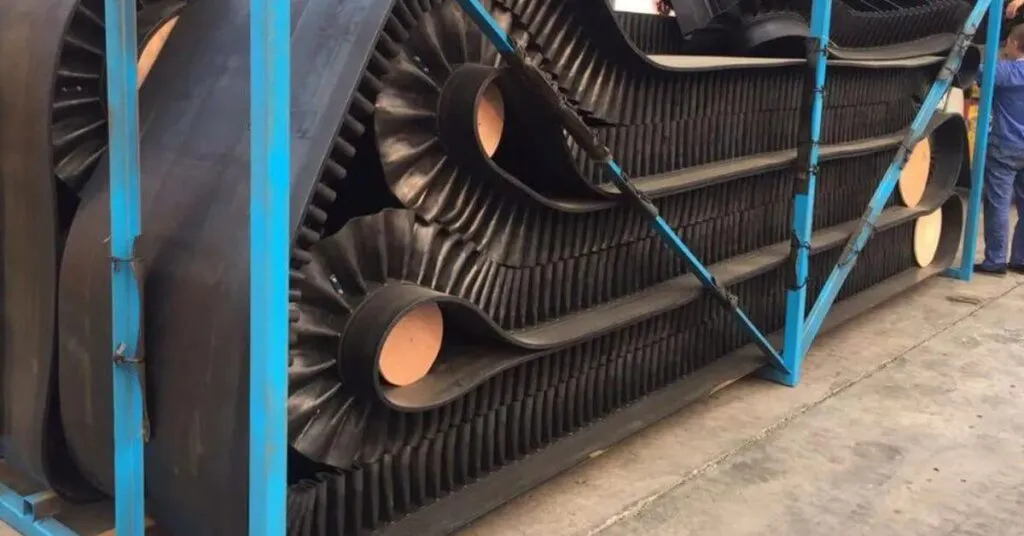Sidewall Conveyor Belts: Enhancing Efficiency and Flexibility in Material Handling – Conveyor belts have long been a staple in industries that require efficient transportation of materials. From mining to agriculture, manufacturing to logistics, these essential systems have played a vital role in streamlining operations. However, when it comes to handling bulk materials, steep inclines, or constrained spaces, traditional conveyor belts may fall short. This is where sidewall conveyor belts come into play, offering a versatile solution that ensures effective and reliable material transportation. In this blog, we will explore the features, applications, and benefits of sidewall conveyor belts, shedding light on their significance in modern industries.
Table of Contents
Understanding Sidewall Conveyor Belts
Sidewall conveyor belts, also known as corrugated sidewall belts, are a specialized type of conveyor belt designed with integral sidewalls and cleats. The sidewalls are attached to the base belt, forming a continuous pocket that contains the conveyed material. The cleats, positioned at regular intervals along the belt, provide additional support and prevent material spillage.
This unique construction allows sidewall conveyor belts to navigate steep inclines, manage bulky materials, and overcome space constraints that would otherwise be challenging for conventional conveyor systems. Monster Belting is the perfect place where you can find these belts that are ideal for bulk handling. They have a wide range of heavy and abrasive materials that successfully cater to various industries, including stone crushing and screening, sand washing, chemical fertilizer, and many more.
Applications and Industries
Sidewall conveyor belts find applications across a wide range of industries that deal with bulk materials and challenging operating conditions. Some notable applications include:
Mining and Quarrying:
Sidewall conveyor belts excel in transporting heavy and abrasive materials such as coal, ores, and aggregates from extraction sites to processing plants or stockpiles.
Construction:
These belts are ideal for transferring bulk materials in construction sites, including concrete, sand, gravel, and rubble, enabling efficient material handling and minimizing manual labor.
Agriculture:
Sidewall conveyor belts are employed in the agricultural sector for handling grain, fertilizers, and other agricultural products, ensuring smooth and efficient transfer from storage to processing or transportation.
Manufacturing:
Sidewall belts are used in manufacturing facilities to transport various materials, including chemicals, plastics, and rubber, optimizing production processes and reducing material handling time.
Waste Management:
Sidewall belts play a crucial role in waste management facilities, aiding in the movement of municipal waste, recyclables, and compost, facilitating proper disposal and recycling procedures.
Benefits of Sidewall Conveyor Belts
Steep Incline Handling:
One of the primary advantages of sidewall conveyor belts is their ability to handle steep inclines. With sidewalls and cleats securely containing the materials, these belts can navigate angles of up to 90 degrees, minimizing spillage and ensuring efficient transportation.
Space Optimization:
Sidewall belts are particularly useful in areas with limited space. The vertical flexibility and compact design enable material transfer in tight spaces, making them suitable for installations where traditional conveyor systems may not be feasible.
Material Containment:
The integral sidewalls and cleats of these belts effectively contain the conveyed material, preventing spillage, and minimizing product loss. This feature is especially beneficial when handling fine or powdery materials that are prone to scattering.
Versatility and Customization:
Sidewall conveyor belts can be customized to meet specific requirements, including varying belt widths, cleat heights, and sidewall angles. This versatility allows for seamless integration into existing systems and ensures optimal performance for diverse material handling needs.
Enhanced Efficiency and Safety:
By eliminating the need for multiple conveyors or manual handling, sidewall belts streamline material transportation processes, reducing labor costs and increasing overall efficiency. Furthermore, the secure containment of materials promotes workplace safety by minimizing the risk of accidents caused by spills or falls.
Conclusion
Sidewall conveyor belts have revolutionized material handling in industries that demand efficient transportation of bulk materials, steep incline handling, and space optimization. Their unique design, incorporating integral sidewalls and cleats, enables them to navigate challenging operating conditions with ease. With applications spanning across mining, construction, agriculture, manufacturing, and waste management, sidewall belts offer enhanced efficiency, increased safety, and customized solutions tailored to specific industry needs. As industries continue to evolve, sidewall conveyor belts remain a reliable and indispensable component in optimizing material handling processes and ensuring smooth operations.

Pradeep Sharma is a author the mind behind Techjustify, where I craft insightful blogs on technology, digital tools, gaming, AI, and beyond. With years of experience in digital marketing and a passion for tech innovation, I aim to simplify complex topics for readers worldwide.
My mission is to empower individuals with practical knowledge and up-to-date insights, helping them make informed decisions in the ever-evolving digital landscape.




